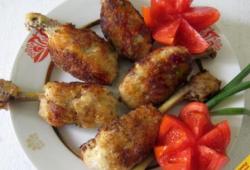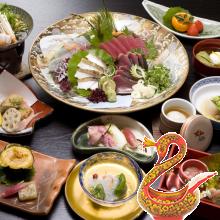Aesthetics of Japanese cuisine
The Japanese prefer to cook meals in honor of some events, and pick them under specific situations.
Cooks necessarily take into account the time of year and the age of the guests while cooking. Winter portions larger than in the warm season. Young guests portions overlap more than the elderly. In the northern parts of the country of the rising sun to eat more than in the south. Products are used only fresh and at the time of year when their flavor is most pronounced. Bamboo shoots prefer to add to spring dishes, and lotus root - for winter or autumn. In the summer, in the heat, the Japanese eat light vegetable soups, and in the warmer months they love snacks such as fried eel, cold noodles with Perillo. The food is served in a beautiful glass dish. Fall can be made of persimmon, and the dishes are decorated with sculptured cut carrots.
In the traditional Japanese table aesthetics and color combination of products plays an important role. Local chefs make a variety of jewelry from vegetables: turnips, radishes, pumpkins. In winter, on the tables as decorations can be seen tangerines and more frequent decoration catering establishments are small vessels with pebbles stuck with an umbrella, which symbolizes protection from bad weather conditions. To see uponskie decoration of dishes you can order on the house itself a Japanese dinner.
Earlier in the land of the rising sun, a fairly long period, dishes decorated with vibrant colors. But there has recently been neglecting this traditsiey- used as decor inedible items such as a branch of the cherry blossoms, it becomes unfashionable.
Japanese products are prepared in such a way that they can be taken without problems chopsticks. Fish served boned, radish cleaned so that it could even have any problems with the gums.
Traditionally used for serving black crockery to food, such as white rice, pleasing to the eye and looked impressive against a dark background. Essential beauty of contrast. It goes well with low capacitance high, with a rounded square. First, you can see some asymmetry in such combinations, but in fact this design symbolizes the harmony.
Snacks on a plate usually decomposed odd. For example, sashimi may be 3 or 5, but two or four.
This important rule as matching crockery type of food. Fried food is presented on trays made of porcelain or bamboo, sashimi - on porcelain supports. Rice or soup is presented in round bowls, rice with seafood and vegetables - in the middle, and in the largest lapsha-. Covers that are at the top, not only keep warm, but also allow you to enjoy plenty of flavor.
The country must adhere to the rules of white space - the plates are never filled completely and put on the table all at once.
The soup is eaten hot, but most of the dishes used a little ostyvshimi.
- Log in to post comments














